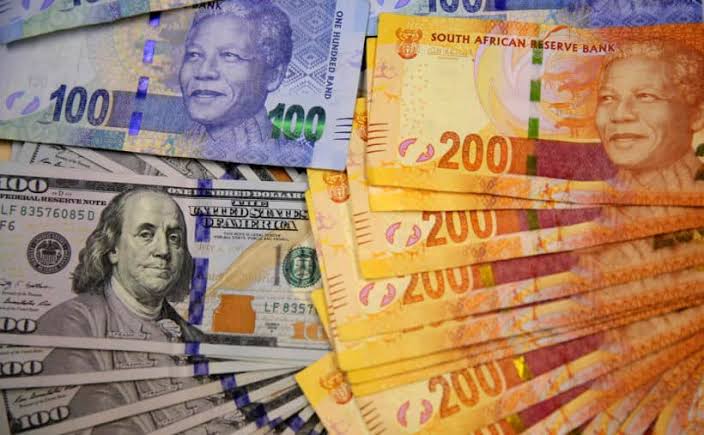
South African rand weakened against stronger U.S. Dollar
Reuters: The South African rand weakened about 1% on Thursday against a stronger U.S. dollar as a spate of interest rate hikes by several central banks fuelled worries about global growth. SOUTH AFRICAN RAND WEAKENED At 1528 GMT, the rand traded at 18.5000 against the dollar, about 1% weaker than its previous close. The safe-haven […]

Reuters: The South African rand weakened about 1% on Thursday against a stronger U.S. dollar as a spate of interest rate hikes by several central banks fuelled worries about global growth.
SOUTH AFRICAN RAND WEAKENED
At 1528 GMT, the rand traded at 18.5000 against the dollar, about 1% weaker than its previous close. The safe-haven dollar last traded at 102.420 – about 0.4% stronger – against a basket of global currencies. The rand has fallen this week after making strong gains since the beginning of June, partly because easing power cuts improved investor sentiment. “The multi-week trend looks like it is over,” said Rand Merchant Bank analysts in a research note.
ALSO READ: Elon Musk gets richer – and richer: How much is the SA-born billionaire worth?
Like most emerging market currencies, the risk-sensitive rand is susceptible to moves in global drivers such as U.S. economic data and the dollar in the absence of local catalysts. On the stock market, the Top-40 and the broader all-share index both closed down about 0.7%. South Africa’s benchmark 2030 government bond was stronger, with the yield down 3 basis points to 10.690%.
U.S. DOLLAR
Reuters: The dollar drew support from a bout of risk aversion on Friday as hawkish comments from global central banks, including the Federal Reserve, stoked fears that their aggressive monetary tightening could push economies into a deeper downturn. Sterling struggled to hold gains from a larger-than-expected 50-basis-point rate rise from the Bank of England on Thursday in response to sticky inflation, fuelling fears about an impending recession in the UK. While higher rates are typically supportive of currencies, the risk that they will trigger an economic downturn has pushed some investors to seek safe-haven assets including the U.S. dollar. The pound fell 0.33% to $1.2707 and was on track for a weekly loss of nearly 1%, snapping three straight weeks of gains. “With the Bank of England set to raise rates substantially further, we expect the UK economy to come under renewed pressure by late 2023, and look for growth to either stagnate or even for the economy to contract,” said Nick Bennenbroek, international economist at Wells Fargo.
The Australian and New Zealand dollars also struggled in Asia trade as risk appetite waned. The Aussie tumbled 0.9% to $0.6696 and was headed for a weekly loss of more than 2.5%, its worst week since March. The kiwi slid 0.59% to $0.61405, down about 1.5% for the week. Rate hike surprises and hawkish comments from central banks globally have renewed market fears that policymakers have further to go in tightening policy to tame inflation, even at the risk of tipping their economies into a recession. Norway’s central bank on Thursday also stunned markets with a 50 bp rate hike and said it aimed for another hike in August. The Swiss National Bank raised its policy interest rate by 25 bps the same day and signalled more tightening to come. “Markets are definitely taken by surprise by the recent, more aggressive actions that some central banks had to take,” said Khoon Goh, head of Asia research at ANZ. “Also putting into question the following trend of other central banks that initially looked like they’ve paused but went on to hike rates so that’s something that markets are starting to become worried about again.”
ALSO READ: Who is the richest person in the world today? Top 10 list – 23 June 2023
The Reserve Bank of Australia and the Bank of Canada had earlier this month delivered surprise rate hikes when markets were leaning towards pauses. Elsewhere, the euro fell 0.24% to $1.0929. The U.S. dollar index rose 0.25% to 102.65 and was on track for a weekly gain, reversing three straight weeks of losses. Fed Chair Jerome Powell said on Thursday the central bank would move interest rates at a “careful pace” from here. Money markets now see a 74% chance that the Fed will raise interest rates by 25 bps at its policy meeting next month, after leaving it unchanged last week. Against the dollar, the yen fell marginally to 143.19, languishing near an over seven-month low of 143.23 per dollar hit in the previous session. The Japanese currency has come under renewed pressure as the Bank of Japan continues to maintain its ultra-dovish stance.
Data out on Friday showed that Japan’s core consumer inflation exceeded forecasts in May and an index excluding fuel costs rose at the fastest annual pace in 42 years, putting pressure on the BOJ to phase out its massive stimulus. The Chinese offshore yuan slid to a fresh seven-month low of 7.2285 per dollar, reflecting concerns over the country’s faltering economic recovery. Markets in China were closed for a holiday on Friday. The Turkish lira slid to a record low of 25.59 against the U.S. dollar. Turkey’s central bank on Thursday hiked its key rate by 650 basis points to 15%, but the post-election tightening missed expectations.
ALSO READ: Making ends meet. Inflation lowers to a 13 month low
BRITISH POUND
Reuters: The pound held steady against the dollar and euro after an initial surge during a volatile trading session on Thursday following the Bank of England’s decision to raise interest rates by 50 basis points. At 1350 GMT, sterling was down 0.13% versus the dollar at $1.2751, and very slightly down against the euro at 86.13 pence. The yield on the 2-year gilt , which is highly sensitive to interest rate expectations, wavered after the BoE’s decision and was little changed at 5.04%. There was also an inversion of the 2- to 10-year yield curve , which often signals that investors expect a recession in the British economy.
Joe Tuckey, head of FX analysis at Argentex said that despite a knee-jerk upside reaction to the 50 bps hike, sterling could struggle to make headway as markets anticipate the negative pressure that higher rates will have on the economy. “The lag effect of yet more tightening may mean that UK economic data is bound to deteriorate in coming months,” Tuckey said. UK homebuilders’ and banking stocks also fell following the rate hike. The BoE’s decision raised interest rates to 5%. Prior to the announcement, traders indicated there was a roughly 50% chance of a 50 bp increase and a 50% chance of a 25 bp hike. “The Bank of England has surprised markets with a 50 basis-point rate hike, following a series of smaller moves through this year,” James Smith, developed markets economist at ING, said, pointing to this week’s inflation data which saw what he called a “material spike” in services inflation.
ALSO READ: Presidential Youth Employment Initiative empowers young people
Markets now see a 66% chance of a 25 bp rise at the BoE’s next meeting in August and a 34% chance of a 50 bp hike, and anticipate rates will peak at 6% in December, up marginally from 5.9% earlier. Wednesday’s data, which showed the rate of inflation remained unchanged from the previous month at 8.7%, saw the pound retreat against the dollar and euro as money managers expected the task faced by the BoE to be more substantial than initially envisioned. British finance minister Jeremy Hunt said the Bank of England had his full support and “tackling inflation relentlessly must be the immediate priority”, in a letter to BoE Governor Andrew Bailey after the central bank raised interest rates.
GLOBAL MARKETS
Reuters: Asian stocks headed for their worst week in three months on Friday as a string of hotter-than-expected inflation prints and hawkish central bank surprises made investors nervous about the economic toll of taming runaway prices. MSCI’s broadest index of Asia-Pacific shares outside Japan fell 0.7% and is down 3.6% for the week, its worst since March. Trade was lightened by a holiday in China. Hong Kong shares returned from a break with a 1.4% drop. Japan’s Nikkei fell 1% as core inflation in Japan hit its fastest pace in more than four decades. On the heels of sticky British inflation data, the news set off a wave of risk-aversion, said Wong Kok Hoong, head of equity sales trading at Maybank in Singapore. The Nikkei was set to snap a ten-week winning streak with a 2.4% weekly drop. Wall Street had eked gains overnight, but S&P 500 futures fell 0.4% on Friday.
ALSO READ: Itukise Programme graduation ceremony empowers graduates
Overnight central banks in Britain and Norway delivered super-sized 50 basis point hikes. Last week the U.S. Federal Reserve surprised markets with a hawkish outlook and central banks in Australia and Canada have delivered unexpected hikes. The Bank of England’s hike to 5%, in the face of sticky inflation and surprisingly strong wages prompted only the briefest jump in sterling before it fell along with gilt yields fell as investors worry tightening will bring economic pain. “The tight labour market in the UK, given its predominately labour-intensive service-based economy, is proving increasingly problematic and exemplifies the risk in other advanced economies,” said ANZ economist Henry Russell in a note. “Although moves in rates and foreign exchange were muted, there does seem a sense that more tightening is coming in the northern hemisphere,” he said.
The U.S. dollar advanced on Friday and was set for its strongest weekly performance in a month. The Australian dollar, which is sensitive to commodity prices and Chinese growth fell 0.5% to $0.6724 and was down more than 2% on the week. With onshore markets closed the offshore yuan extended recent losses and slid to a new seven-month trough of 7.2225 per dollar. Maybank’s Wong said the market was not buying week-old promises of stimulus to support China’s stalling post-pandemic recovery. “Sentiment’s weak,” he said. In bond markets U.S. Treasuries were sold overnight when Fed Chair Jerome Powell reiterated that further rate hikes are likely. Two-year Treasury yields rose 9 bps to 4.8% overnight and were steady at 4.7888% in Asia on Friday.
ALSO READ: Small businesses embrace the 4R method for effective marketing
Ten-year Treasury yields rose 7.6 bps overnight and held at 3.7849% on Friday. The prospect of higher rates hit gold, which pays no income, and spot prices slid to three-month lows at $1,910 an ounce. Brent crude futures were set for their worst week in nearly two months and fell 0.5% to $73.79 a barrel. Later on Friday purchasing managers index surveys are due in Europe, Britain and the United States, and British retail sales figures are expected to show a slip into reverse.
